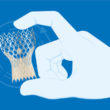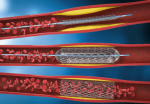Currently, transfemoral access (TFA) is used in large-caliber procedures and when transradial access is not successful. The use of ultrasound (US) to guide access has emerged as a technique that allows for precise cannulation, avoiding accesses above and below the inguinal ligament. However, evidence regarding the effectiveness of this tool has shown variable results. Two...
Cardiac Angiography: Necessary for CABG Patient Diagnosis?
Cardiac revascularization surgery (CABG) has shown positive results at long term in CAD patients with multivessel or left main disease. However, we are well aware that, after CABG, there might be native disease progression over time. Also, at followup, we often see high incidence of venous graft failure. According to registry data, approximately 1 in...
TAVR in Asymptomatic or Minimally Symptomatic Patients: 30-Day Results
Aortic valve replacement (AVR) is recommended for symptomatic aortic stenosis (AS), while close monitoring is the advised strategy for asymptomatic patients, unless they have elevated aortic gradients, reduced ejection fraction, or abnormal stress tests. However, the optimal timing for AVR remains uncertain, especially in light of recent evidence suggesting that AS patients showing signs of...
Treatment and Gender-Based Outcomes for Coronary Bifurcation Stent Placement: Report from the e-ULTIMASTER Registry
Approximately 20% of all percutaneous coronary interventions (PCI) are performed on bifurcation lesions, which continue to pose a challenge in terms of strategy: how many stents to use, what is the most suitable strategy, and when to transition from a single stent to two during the procedure. Additionally, the use of two stents in these...
TriClip: Good Outcomes After a 2-Year Follow-up
Severe tricuspid regurgitation (TR) is an underestimated condition in healthcare systems. However, it is more common than believed, especially in individuals over 65 years of age. This condition is linked to hospitalizations due to heart failure, mortality rates, and a progressive decline in quality of life. Surgery to treat TR on its own is complicated,...
Prognostic Impact of SYNTAX and SYNTAX II Scores in Patients with Acute Myocardial Infarction
Acute myocardial infarction (AMI) continues to be a clinically significant condition due to its association with morbidity and mortality after the initial event. Therefore, the prognostic stratification of these patients is of vital importance. One of the tools that have been used for several years for this purpose is the SYNTAX I (SS) and SYNTAX...
ISCHEMIA Trial: Does Complete Anatomical or Functional Revascularization Modify Anything Compared with Medical Treatment?
Chronic coronary syndrome (CCS) has been considered another comorbidity in previous studies, and there has been no significant reduction in cardiovascular mortality or myocardial infarction (MI) rates with revascularization through percutaneous coronary intervention (PCI) or myocardial revascularization surgery (MRS) compared with optimal medical treatment (OMT). One possible reason for the lack of benefit has been...
TRILUMINATE Two Years In: Encouraging Results
Tricuspid valve regurgitation is more common than one might think. It often stems from left valve disease and associated with increased mortality and hospitalization due to heart failure, which is not easy to treat. Currently, guidelines list surgery as the recommended treatment, though this option is quite complex and might entail complications and mortality risk....
OCT-Guided PCTA: Does It Offer any Benefits?
For many years, percutaneous transluminal coronary angioplasty (PCTA) has expanded significantly worldwide. However, despite the demonstrated advantages of intravascular ultrasound (IVUS) in terms of minimal luminal area, reduced cardiovascular events, and restenosis, its use is not very common due to various reasons. On the other hand, optical coherence tomography (OCT) offers even higher resolution than...
TAVI-in-TAVI with Balloon-Expandable Valves
TAVI (Transcatheter Aortic Valve Implantation) has proven to be beneficial and is currently performed in increasingly younger and lower-risk patients. However, as with surgical bioprostheses, structural deterioration, whether due to stenosis or regurgitation, is one of the challenges we must address. While currently uncommon, this is an issue we will probably see more and more...







